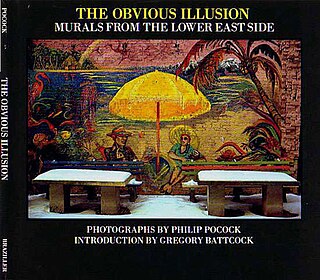Related Research Articles
Video art is an art form which relies on using video technology as a visual and audio medium. Video art emerged during the late 1960s as new consumer video technology such as video tape recorders became available outside corporate broadcasting. Video art can take many forms: recordings that are broadcast; installations viewed in galleries or museums; works either streamed online, or distributed as video tapes, or on DVDs; and performances which may incorporate one or more television sets, video monitors, and projections, displaying live or recorded images and sounds.

Manfred Mohr is a German artist considered to be a pioneer in the field of digital art. He has lived and worked in New York since 1981.

Philip Pocock is a Canadian artist, photographer and researcher. He was born in Ottawa, Ontario, in 1954. Since the early 1990s, his work has been collaborative, situational, time-, code-, net-based and participatory.

Peter Weibel was an Austrian post-conceptual artist, curator, and new media theoretician. He started out in 1964 as a visual poet, then later moved from the page to the screen within the sense of post-structuralist methodology. His work includes virtual reality and other digital art forms. From 1999 he was the director of the ZKM Center for Art and Media Karlsruhe.

The ZKM | Center for Art and Media Karlsruhe, a cultural institution, was founded in 1989 and, since 1997, is located in a former munitions factory in Karlsruhe, Germany. The ZKM organizes special exhibitions and thematic events, conducts research and produces works on the effects of media, digitization, and globalization, and offers public as well as individualized communications and educational programs.
Julia Scher is an American artist who works primarily with themes of surveillance. She uses a variety of mediums and is most known for her installation art and performance art works. Her work addresses issues of control and seduction.

Hans Belting was a German art historian and media theorist with a focus on image science, and this with regard to contemporary art and to the Italian art of the Middle Ages and the Renaissance.
Jeffrey Shaw is a visual artist known for being a leading figure in new media art. In a prolific career of widely exhibited and critically acclaimed work, he has pioneered the creative use of digital media technologies in the fields of expanded cinema, interactive art, virtual, augmented and mixed reality, immersive visualization environments, navigable cinematic systems and interactive narrative. Shaw was co-designer of Algie the inflatable pig, which was photographed above Battersea Power Station for the 1977 Pink Floyd album, Animals.
Scenario is an Artificial Intelligence (AI) computer graphic interactive installation, directed by the artist Dennis Del Favero, and developed in collaboration with scriptwriter Stephen Sewell, AI scientist Maurice Pagnucco working with computer scientists Anuraag Sridhar, Arcot Sowmya and Paul Compton. It is a 360-degree 3D cinematic work whose narrative is interactively produced by the audience and humanoid characters. The title is a Commedia dell'arte term referring to the way dramatic action is dependent on the way actors and audience interact. Scenario was developed at the iCinema Centre for Interactive Cinema Research.

Dieter Jung is a German artist working in the field of holography, painting and installation art. He lives and works in Berlin.
Timo Kahlen is a German sound sculptor and media artist who currently lives and works in Berlin.
Grégory Lasserre & Anaïs met den Ancxt are also known under their artist name Scenocosme.

Marc Lee is a Swiss new media artist working in the fields of interactive installation art, internet art, performance art and video art.
Erkki Huhtamo is a media archaeologist, exhibition curator, and professor at the University of California, Los Angeles, in the Departments of Design Media Arts and Film, Television, and Digital Media.
Peter Zimmermann is a German painter, sculptor, object artist and university professor.

Kamila B. Richter is a Czech media artist.

Michael Bielicky is a Czech-German artist working in new media, video art, and installations. He is a professor in the department of digital media and post-digital narratives at the Karlsruhe University of Arts and Design. In 1989, Bielicky's artwork Menora/Inventur became his first work to be acquired by the ZKM Center for Art and Media Karlsruhe by its founder Heinrich Klotz.
Richard Castelli is a producer, artistic consultant and curator of numerous exhibitions associated with art, science, performance, or new technologies.

Eku Wand is a German Designer and Multimedia director. Wand is a professor of media design and multimedia at the Braunschweig University of Art with a research focus on Interactive Storytelling.
References
- ↑ "Fellow Profile: Dennis Del Favero". Australian Academy of the Humanities. Retrieved 24 November 2024.
- ↑ n/a, n/a (11 September 2017). "Dennis Del Favero". Wall Street International Magazine. Retrieved 7 December 2019.
- ↑ Del Favero, Dennis. "Penumbra2.0". ACM SIGGRAPH Asia. ACM. Retrieved 13 January 2025.
- ↑ Del Favero, Dennis. "Visualizing the Unpredictable Behavior ofWildfire Using an Artificially Intelligent Aesthetic" (PDF). Proceedings ISEA 2022 Barcelona. ISEA International. Retrieved 13 January 2025.
- ↑ Del Favero, Dennis (2 May 2024). Climate Disaster Preparedness Reimagining Extreme Events through Art and Technology (1 ed.). Cham: Springer. p. 219. ISBN 978-3-031-56114-6 . Retrieved 13 January 2025.
- ↑ Del Favero, Dennis. "A new immersive cinema is helping firefighters to better prepare for megafires". The Conversation. The Conversation Australia and New Zealand. Retrieved 13 January 2025.
- ↑ Del Favero, Dennis (July 2023). "Culture and climate: A dangerous gap in policy and practice". AAH on Culture & Climate. Australian Academy of the Humanities. Retrieved 13 January 2025.